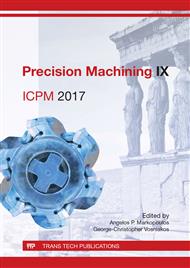[1]
L. Dudás, Design of nonconventional grinding wheels with specialized CAD system, Proc 4th IEEE Int Symp Logist Ind Inform LINDI (2012), 21-26.
DOI: 10.1109/lindi.2012.6319503
Google Scholar
[2]
W. Habrat, Effect of Bond Type and Process Parameters on Grinding Force Components in Grinding of Cemented Carbide, Proc Eng 149 (2016) 122-129.
DOI: 10.1016/j.proeng.2016.06.646
Google Scholar
[3]
V. Bana, B. Karpuschewski, J. Kundrák, A.M. Hoogstrate, Thermal distortions in the machining of small bores, J Mat Process Tech 191(1–3) (2007) 335–338.
DOI: 10.1016/j.jmatprotec.2007.03.027
Google Scholar
[4]
J. Kundrák, G. Varga, Possibility of reducing environmental load in hard machining, Key Eng Mat 496 (2012) 205-210.
DOI: 10.4028/www.scientific.net/kem.496.205
Google Scholar
[5]
L. Dudás, Extending a gear CAD application with special space feature objects, Proc IEEE 11th Int Symp Appl Mach Intel Inform SAMI (2013) 239-244.
DOI: 10.1109/sami.2013.6480983
Google Scholar
[6]
P. Tamás, B. Illés, Process improvement trends for manufacturing systems in industry 4. 0, Academ J Manuf Eng 14(4) (2016) 119-125.
Google Scholar
[7]
J. Kundrak, C. Felho, 3D roughness parameters of surfaces face milled by special tools, Manuf Tech 16(3) (2016) 532-538.
DOI: 10.21062/ujep/x.2016/a/1213-2489/mt/16/3/532
Google Scholar
[8]
R. Rentsch, I. Inasaki, Molecular Dynamics Simulation for abrasive processes, CIRP Ann 43 (1994) 327-330.
DOI: 10.1016/s0007-8506(07)62224-0
Google Scholar
[9]
R. Komanduri, N. Chandrasekaran, L.M. Raff, Some aspects of machining with negative-rake tools simulating grinding: A molecular dynamics simulation approach, Philos Mag B 79 (1999) 955-968.
DOI: 10.1080/13642819908214852
Google Scholar
[10]
J. Shimizu, L.B. Zhou, H. Eda, Simulation and experimental analysis of super high-speed grinding of ductile material, J Mater Process Tech 129 (2002) 19-24.
DOI: 10.1016/s0924-0136(02)00568-x
Google Scholar
[11]
B. Lin, S.Y. Yu, S.X. Wang, An experimental study on molecular dynamics simulation in nanometer grinding, J Mater Process Tech 138 (2003) 484-488.
Google Scholar
[12]
P.M. Agrawal, R. Narulkar, S. Bukkapatnam, L.M. Raff, R. Komanduri, A phenomenological model of polishing of silicon with diamond abrasive, Tribol Int 43 (2010) 100-107.
DOI: 10.1016/j.triboint.2009.05.003
Google Scholar
[13]
W.J. Zong, X. Cheng, J.J. Zhang, Atomistic origins of material removal rate anisotropy in mechanical polishing of diamond crystal, Carbon 99 (2016) 186-194.
DOI: 10.1016/j.carbon.2015.12.001
Google Scholar
[14]
S. J Eder, D. Bianchi, U. Cihak-Bayr, A. Vernes, G. Betz, An analysis method for atomistic abrasion simulations featuring rough surfaces and multiple abrasive particles, Comput Phys Commun 185 (2014) 2456-2466.
DOI: 10.1016/j.cpc.2014.05.018
Google Scholar
[15]
S. J. Eder, U. Cihak-Bayr, D. Bianchi, Single-asperity contributions to multi-asperity wear simulated with molecular dynamics, IOP Conf Ser – Mat Sci 119 (2016) 012009.
DOI: 10.1088/1757-899x/119/1/012009
Google Scholar
[16]
A.P. Markopoulos, I.K. Savvopoulos, N.E. Karkalos, D.E. Manolakos, Molecular dynamics modeling of a single diamond abrasive grain in grinding, Front Mech Eng 10 (2015) 168-175.
DOI: 10.1007/s11465-015-0337-y
Google Scholar
[17]
A.P. Markopoulos, N.E. Karkalos, D.E. Manolakos, Molecular dynamics study of abrasive grain morphology and orientation in nanometric grinding, Key Eng Mat 686 (2016) 7-12.
DOI: 10.4028/www.scientific.net/kem.686.7
Google Scholar
[18]
P.A. Romero, G. Anciaux, A. Molinari, J. -F. Molinari, Insights into the thermo-mechanics of orthogonal nanometric machining, Comput Mater Sci 72 (2013) 116-126.
DOI: 10.1016/j.commatsci.2013.01.036
Google Scholar
[19]
S. Goel, The current understanding on the diamond machining of silicon carbide, J Phys D: Appl Phys 47 (2014) 243001.
DOI: 10.1088/0022-3727/47/24/243001
Google Scholar
[20]
L. Zhang, H. Tanaka, Towards a deeper understanding of wear and friction on the atomic scale – A molecular dynamics analysis, Wear 211(1) (1997) 44-53.
DOI: 10.1016/s0043-1648(97)00073-2
Google Scholar
[21]
K. Uezaki, J. Shimizu, L. Zhou, Development of metal cutting process accompanied by a localized compressive hydrostatic stress field formation: Examination by molecular dynamics simulation, Precis Eng 38(2) (2014) 371-378.
DOI: 10.1016/j.precisioneng.2013.12.002
Google Scholar
[22]
J. Li, B. Liu, H. Luo, Q. Fang, Y. Liu, Y. Liu, A molecular dynamics investigation into plastic deformation mechanism of nanocrystalline copper for different nanoscratching rates, Comp Mater Sci 118 (2016) 66-76.
DOI: 10.1016/j.commatsci.2016.03.008
Google Scholar


